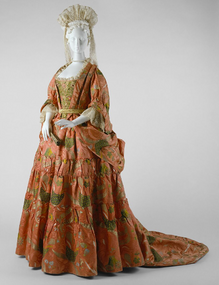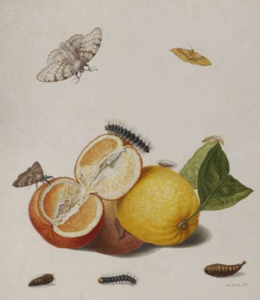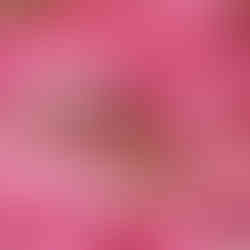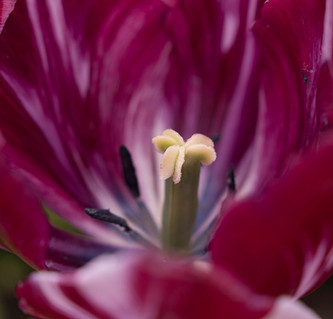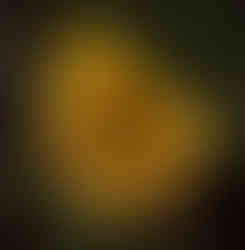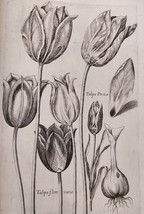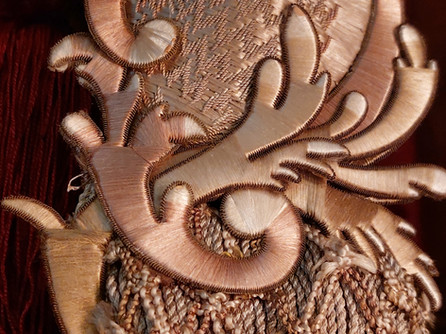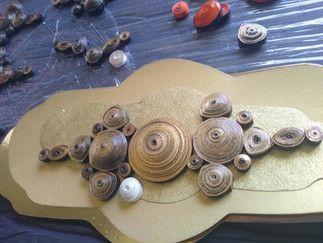1690's - research & making - Copper Tulips
- Stephanie Smart
- Sep 30
- 15 min read
Silk history
"Silk had been woven in England since the late Middle Ages and in London from at least 1551. The industry expanded significantly in the last quarter of the seventeenth century. At the same time Canterbury also became a centre of silk manufacture. Always smaller and less specialised, it peaked in the 1690s and many silk weavers and their families left for London around 1700. The level of activity was such that production moved outside the walls of the City of London and into the suburbs to the East. London weavers produced silk for clothing and accessories; they did not make silks for furnishings."
Royalty
William III (1650–1702) and Queen Mary II (1662–1694) reigned from 1689-1702 and 1689-1694, in the era of the Stuarts:

For a list of Royal lineage up until this time please see: https://www.historic-uk.com/HistoryUK/KingsQueensofBritain/
William III (William Henry) Dutch (Willem Hendrik) was also known as William of Orange. He was the sovereign Prince of Orange from birth as well as Stadtholder of Holland, Zeeland, Utrecht, Guelders, and Overijssel in the Dutch Republic from the 1670s, and King of England, Ireland, and Scotland from 1689 until his death in 1702. As King of Scotland, he was known as William II. He ruled Britain and Ireland alongside his wife, Queen Mary II. Their joint reign is known as that of William and Mary.
Mary II was Queen of England, Scotland, and Ireland, co-reigning with her husband, William III & II, until her death in 1694. She was also Princess of Orange following their marriage on 4 November 1677. Mary died from smallpox at the age of 32 and William was then sole ruler until his death in 1702, when he was succeeded by Mary's sister, Anne.
William and Mary on the ceiling of the Painted Hall in Greenwich
Note: Elsewhere in my research I would be looking for the
image of a unicorn so I was glad to find it
on William and Mary's coat of arms:
William was the only child of William II, Prince of Orange, and Mary, Princess Royal, was the daughter of King Charles I of England, Scotland, and Ireland. His father died a week before his birth, making William III the Prince of Orange from birth. Mary was his first cousin, the eldest daughter of his maternal uncle James, Duke of York, (the future James II of England, the younger brother and later successor of King Charles II) and his first wife, Anne Hyde
William was Protestant and a principal opponent of the powerful Catholic French ruler Louis XIV...
"...in coalition with both Protestant and Catholic powers in Europe. Many Protestants heralded William as a champion of their faith. In 1685, his Catholic uncle and father-in-law, James, became King of England, Scotland, and Ireland. James's reign was unpopular with the Protestant majority in Britain, who feared a revival of Catholicism. Supported by a group of influential British political and religious leaders, William invaded England in what became known as the Glorious Revolution. In 1688, he landed at the south-western English port of Brixham; James was deposed shortly afterward. William's reputation as a staunch Protestant enabled him and his wife to take power...William's lack of children and the death in 1700 of his nephew Prince William, Duke of Gloucester, the son of his sister-in-law Anne, threatened the Protestant succession. The danger was averted by placing his and Mary's cousins, the Protestant Hanoverians, in line to the throne with the Act of Settlement 1701. Upon his death in 1702, William was succeeded in Britain by Anne and as titular Prince of Orange by his cousin John William Friso."
Portrait of Mary II hanging today at Hampton Court
Note: You can see Mary in almost exactly the same
pose but in a blue dress here:
And you can see her in a similarly orange/copper
coloured gown here:
Changes to the Law:
"...Mary and her sister Anne were raised as Anglicans at the behest of Charles II, although their parents both converted to Roman Catholicism. Charles lacked legitimate children, making Mary second in the line of succession." But when Mary married at the age of fifteen and when Charles died in1685, making James king, Mary became the heir presumptive. "James's attempts at rule by decree and the birth of his son from a second marriage, James Francis Edward (later known as "the Old Pretender"), led to his deposition in the Glorious Revolution of1688 and the adoption of the English Bill of Rights." - https://en.wikipedia.org/wiki/Mary_II_of_England
Had they or their court never even worn the fabric itself William III and Mary II would still be linked firmly to the history of silk in the UK through loyalties induced by religious belief. For when they took to the throne, in 1689, they introduced financial support (The Royal Bounty) for those Huguenots who had already made their way to England which included many silk weavers. You can read more about the Huguenot silk weavers of Spitalfields in my previous post.
Note: You can read more about William and Mary here
Also in the first year of their reign:
"...they asked Christopher Wren to design a new baroque palace for them. Wren scrapped his original plan to demolish the whole palace [Hampton Court] and instead created the spectacular Fountain Court, leaving much of the Tudor palace intact...William and Mary were also responsible for creating many of the most spectacular areas of the Hampton Court Gardens to complement their new palace. These include The Great Fountain Garden, created by Daniel Marot, and a new Privy Garden. The yew trees of the Great Fountain Garden, once neatly pruned, were later allowed to grow to their present height by Capability Brown, head gardener in the mid 18th century. "
- https://www.hrp.org.uk/hampton-court-palace/history-and-stories/the-story-of-hampton-court-palace/
Copper Tulips - Research
I thought it likely that the arch shapes around Fountain Court would feature in the design of the dress that was to be inspired by Mary.

Note: You can read more about Fountain Court here:
William and Mary © Rijks Museum
For another comparable portrait please see:
Whilst researching Mary in particular, and her dress, I noted a seeming inclination to dress in hues of gold, copper, orange. I also began to find the clasps across the bodice of the dress Mary is wearing in the image above, from the Rijks Museum, intriguing. What jewels this particular set are made from is hard to tell as they look almost to be formed of solid metal, but maybe the colour of the paint has aged; could they be huge diamonds perhaps? From then on in my research I quickly began to spot both this manner of decoration on her gowns and her love of pearls. For example, she can be seen in a green gown with clasps of emerald and pearl on a similar bodice at a similar age here: https://fashionhistory.fitnyc.edu/wp-content/uploads/2020/06/Princess_Mary_Stuart_Princess_of_Orange.jpg
Other images of Mary I looked at include: https://i.pinimg.com/originals/26/a7/07/26a707ad8f5dd525d2632f7093eafffd.jpg
Copper
From early on in the process of designing and making this collection I knew how heavily silver and gold must feature. After all the collection was being designed with Royalty in mind. I also wanted to represent the wealth associated with, and being made by Britain and around the world from the trading of silk. The very first piece in the Weaving Silk Stories collection (date wise) however, had to be copper (orange) in honour of the Prince and Princess of Orange.
I went on to look at many more dresses from the 1690's and early 1700's (William ruled until 1702), including this copper orange example from The Met (below). I also looked at dresses from Europe given William's heritage:
please double click on each image to be taken direct to the accredited collection
Images from top left:
©The Met Museum, USA - Mantua, British ca. 1708 https://www.metmuseum.org/art/collection/search/81809
as above https://www.metmuseum.org/art/collection/search/81718
Comtess Mailly, 1698 https://commons.wikimedia.org/wiki/File:La_Comtesse_de_Mailly_(ca._1698).jpg
© Los Angeles County Museum of Art Woman's Dress (Mantua) with Stomacher and Petticoat, Italy, circa 1700 https://collections.lacma.org/node/170609
Note: For an informative fashion timeline of 1690-1699 please click here:
It was when I turned my attention to these two images of Mary explicitly in royal dress (left below), that I found the most spectacular examples of the clasps I had been looking at and would look to reproduce for my Queen Mary era gown:
please double click on each image to be taken direct to the accredited collection
Images from left :
© Royal Collection Trust - Sir Godfrey Kneller (1646-1723) Mary II (1662-1694) signed and dated 1690 Oil on canvas 223.2 x 148.8 x 3.4 cm (support, canvas/panel/stretcher external) RCIN 405674 https://www.rct.uk/collection/405674/mary-ii-1662-1694
© Tregeagle - Queen Mary II of England (1662–1694) Engraved by John Faber Jr (c.1684-1756), after Sir Anthony Van Dyck, Mezzotint 34.6 cm x 25.5 cm (sheet of paper) Published Circa 1745 https://www.tregeaglefineart.com/en-GB/pictures/queen-mary-ii-of-england-1662-1694-mezzotint/prod_10667
© Royal Collection Trust - William III and Mary II c.1788-1702 Mezzotint 26.0 x 35.0 cm (sheet of paper) RCIN 603318 https://www.rct.uk/collection/603318/william-iii-and-mary-ii
Above right you can see her in a similarly shaped gown. The skirt type of this period is called a sultana: https://twonerdyhistorygirls.blogspot.com/2014/07/more-about-sultanas-c1770.html
Note: For an informative fashion timeline of 1680-1689 please click here:
For 1690-1699 please click here:
and for 1700-1708 please click here:
Note: if you're interested in what women of this era
might have worn beneath their dresses please click here

I decided to segment the skirt of the dress I was to make (in part to again represent the orange in Mary's title).
"Copperplate engraving of an orange (Citrus x aurantium L;t.160) as is noted in the accompanying description this is actually a blood orange which had bloomed in the private garden of a noble man on an island off the coast of Provence in Franc; from thence it was brought by Tilli to the Florence gardens. under the name "Jasminum Arabicum" the Catalogus also contains a copper engraving of the still somewhat unfamiliar coffee plant (Coffea arabica L;t.12), whose corresponding watercolour is in the Natural History Museum in London."
- A Garden Eden, Masterpieces of Botanical illustration
H. Walter Lack
I mention the work of Maria Sibylla Merian (1647-1717) in other posts. She was a fine artist/illustrator, an etymologist involved in the study, and pivotal to the eventual understanding of the life cycle of the caterpillar (with particular focus on the caterpillars of silk moths). She was a woman working in the place where science meets art at a time when that was unlikely, if not unheard of. She was a fascinating figure. Below left she shows one of the giant silk moths, the giant Atlas moth, its cocoon and caterpillar. And in both these images she shows us oranges. For more on the giant silk moths please see this post about my research visit to the Natural History Museum.
Citrus fruits were grown as a symbol of status in the era of Mary II. You can read more about the oranges grown at Hampton Court Palace then and now here.
But for the decoration of the sides of this dress I would decide to look at the connection between Mary II and tulips:
"Hampton Court Palace has long been associated with the famous Dutch flower, first introduced in the British Isles in the 1630s. Former resident Queen Mary II, who ruled jointly with King William III, was a keen horticulturist and collected plants from across the globe to feature in their gardens at the palace, including the prized tulip."
Florilegium
"You may well have heard of Queen Mary II's Exoticks Collection (17th-century spelling)...
William lll and Queen Mary ll were very keen horticulturalists...Every year, their vast collections were brought out of the glasshouses and put out on display during the warmer months in various pots of all shapes, sizes and designs."
I visited the annual Tulip festival at Hampton Court as part of my research, to get myself some photographs to work from. Something I am doing more and more regularly as I create a Botanicals page on this website for inspiration from the natural world, in the tradition of collectors and illustrators from the past.

© Historic Royal Palaces
"Botanical painting has a long tradition, going back more than 2000 years, as a way of recording information to aid botanists and herbalists in the identification of plants for medicinal purposes. Later, artists such as Ehret, Bauer and Redoute began to paint rare and beautiful specimens of the plants in collections belonging to wealthy patrons and collectors throughout Europe. These collections are known as Florilegia. These paintings were sometimes bound into books and reproduced in order to be sold to other collectors and institutions."
© Historic Royal Palaces
This plan shows the oldest varieties of tulips that have been grown at Hampton Court Palace Palace

© Historic Royal Palaces
Still today bulbs are sent over by the Hortus Bulborum in Holland and a display of the rare specimen varieties is created in the
Lower Orangery Garden every year with a mass planting also of more modern bulbs.
Referencing an image of a flower with its bulb therefore seemed important:
Some more images from the Hampton Court Tulip Festival:

There are so many colours of tulips that I was able to find the wonderful copper/orange colour I wanted. But there are also variations of the shapes of the flower heads. So before I honed down my selection I wanted to look to the history of silk design to find any ways in which tulips might have featured.
I found orange and deep red tulips in silk designs from 1708 and 1706/07 silk designs by James Leman in the collection of the V&A, London:
Blue and peach ones from 1730 silk design by Anna Maria Garthwaite
and peach/beige ones (possibly faded) from 1734 silk design possibly Joseph Dandridge ©V&A
You can see a streaky one like this in a 1706/07 silk design by James Leman, in the second photo, showing the extended design here: https://collections.vam.ac.uk/item/O65124/design-leman-james/?carousel-image=2006AL2197
Here are some further links I found interesting regarding the popularity and spread of the mania for tulip collection:
https://www.english-heritage.org.uk/visit/inspire-me/blog/blog-posts/tulips-time-mania-mainstream/
https://blog.hrp.org.uk/gardeners/spring-again-tulips-from-amsterdam-hampton-court-palace/
https://tulipconservation.wordpress.com/2018/11/02/a-brief-history-of-tulips/
https://interestingengineering.com/culture/historyecting-guides-antiques/a-history-of-the-tulip
https://www.bbc.co.uk/news/business-51311368 -of-the-tulip-from-turkish-love-affair-to-dutch-tulipmania-obsession
https://www.southernliving.com/garden/flowers/cheekwood-estate-gardens-tulips
Drawing tulips
But photographing them wasn't historically accurate. I had to look to drawing. The visit I made to the library at Kew gardens during this project was made primarily for this reason.
Bry, Johann Theodor de (1561-1623) Vallet, Pierre
Author Bry, Johann Theodor de (1561-1623) Vallet, Pierre (c1575-c1657)
DEB Publication Date: 1611
It would be these that I would focus upon for the dress
But I also saw in person some by Maria Sibylla Merian
Author: Merian, Maria Sibylla (1647-1717), Merian, Dorothea Maria Henriette (1678-1745), Publication Date 1717
Author Redouté, Pierre Joseph (1759-1840) RED Publication Date 1827 1828 1829 1830 1831
Ornamentation
If tulips were to be part of the design of the skirt (as it was now becoming obvious to me they must) the clasps I mentioned above were to be a feature on the bodice and the skirt. And I was finding them a feature of dresses in many portraits of the time. This is Queen Charlotte (wife of George II)
please double click on each image to be taken direct to its source
And there are two more here:
So my next step was to look in a little more detail at anything I could find out about Queen Mary's preferences in terms of jewellery. It was likely I would be tying in the colour of the clasps to the colour of the dress but it was interesting to see what I could find out about what she might have chosen, by looking at more images still of what she wore. The first site I came across in this regard detailed the jewels on the crown that was made especially for her as was, or course, joint ruler https://en.wikipedia.org/wiki/State_Crown_of_Mary_of_Modena
I looked also at the black spots on the ermine that many royal figure are portrayed wearing and I wondered about the use of black alongside the pearls that appear commonplace on her dresses (this is illustrated well in black and white here). I certainly planned to use gold. The striking combination of black and gold is beautifully illustrated on this coronation medal box owned by Mary and William: https://www.rct.uk/collection/search#/1/collection/22171/tortoiseshell-box-with-coronation-medal-for-william-iii-and-mary-ii
If I was to use black that meant I needed to consider jet, which of course became truly fashionable when Queen Victoria was in mourning for Albert but which in fact has a much longer history in this country. As you can read here: https://www.english-heritage.org.uk/visit/inspire-me/history-of-jet-jewellery/
Involving jet in the jewels seemed symbolic also of Mary's untimely death from smallpox in late 1694.
Then I came across this portrait:

Mary II
Image credit Highland Council
Inverness Museum & Art Gallery
Are these jewels jet? Certainly in their use around the top of the bodice their dark hue gives the impression of ermine and her dress has a copper hue. She can be seen dressed in similar colours here: https://artuk.org/discover/artworks/mary-ii-16621694-13554
and here: https://artuk.org/discover/artworks/mary-ii-16621694-49381 and https://i.pinimg.com/originals/84/94/49/849449c5a7036a7b7d75821004f9c44c.jpg
Pearls
In the portraits of her she is draped in strings of them, They hang from her. What is it to be a queen? Your existence is somehow gilded and perhaps (were it a word) pearlised?
Pearls - are made by marine oysters and freshwater mussels as a defence against any irritant that enters their shell. A grain of sand or a parasite, for example, might cause damage to their fragile bodies. So they slowly secrete from within thin layers of the same material that lines as their protective external shells. This substance is called nacre, otherwise known as mother-of-pearl. The beauty of a pearls therefore hides the irritant at its heart.
In many portraits of her she has pearls around her waist. Here is an example in the National Trust's collection: https://www.nationaltrustcollections.org.uk/object/1129214
And if you click on this image of Queen Caroline you can see that from the pearls around the waist hangs a tassel.
Tassels
Then I went to Paris and saw tassels from this period at Declerq's Passementerie. They are French, of course, but there was great cross-fertilization in terms of ideas for using silk thread in passementerie for interiors and fashion between Paris and London, and not only in the move of French Huguenots across the channel.
And what about this!
Below you can see a modern example of the technique of silk wrapping. This traditional technique involves, in fact, a very fine metal wire in a very tiny coil around the edge of a shaped piece of card. The write catches the thread and holds it in place. But of course as pieces of The House of Embroidered Paper are made of nothing other than paper (including card) and thread, so wire isn't an option. To shape something similar therefore I was going to have to adapt the technique.
The height of the mannequin
The ideas were coming together. I had also learnt during this time that Mary was tall (5 foot 11 inches; 180 cm) so the mannequin that I would make the Mary II inspired dress on would need to stand tall likewise.
Birds
Mary had an aviary at Hampton Court:
"Mary's collection of bird species started at Het Loo, the palace she and William built in the Netherlands. There she had a private kitchen and grotto, known as the Queen's tea room, which connected to a birdcage and her gardens. The birdcage may included ‘little green birds with red heads’ purchased by Mary whilst in Holland and was designed by William’s favourite William Bentinck. The design was approved by Mary in 1688. According to inventories of the palace from 1713, the aviary also included a vulture, crane, water birds and many small bird cages within it.
In England, the aviary at Hampton was not built until 1700. At Kensington, Mary had canaries, finches and other songbirds, though, as far as I know, there wasn’t a specific aviary. There were birdcages in her Gallery, though. Windsor had an aviary which kept exotic birds in the Rangers Lodge in the Little Park, but...this palace wasn’t really used by Mary and the birds were probably chosen by Admiral George Churchill."
- Holly Marsden Phd student
I had found links already between the Huguenot silk weavers and songbirds. Now I had a link likewise between the Royal household and birdlife
This piece of fabric from the time caught my attention, combining birds into the design as it does. The birds depicted more likely reflect Mary's own collection with a peacock included. https://collectionsvam.ac.uk/item/O357987/textile-unknown/
For interest here you can see some other English textile designs from that period
So where should the birds be on the dress?
Lace
Lace falls from the stiff upper sleeves of the dresses Mary wore as an adult queen. It likewise informs the dresses she wore as a child. Court artists like Van Dyck worked directly with the royal family. This portrait of the 6 years old Mary is a statement of royal wealth, the expensive lace, pearls and golden damask, but it's also a lovely portrait of a little girl with her hands clasped in front of her silver apron.

Anthony Van Dyck, Princess Mary Stuart (detail) c1637.
Copper tulips - the design

Making
This piece was obviously going to give me shades of colour that would be gorgeous to work with.

For the jewels on the front then I began quilling in copper edged black quilling paper:
I then incorporated gold edged black papers also
I looked at embossing areas of gold card to mimic metal but moved away from that in the end.
Using orange paper tablecloth through sponsorship from Duni Global and copper coloured satin effect tissue paper I began to construct the bodice.
Then there was the tulip for the skirt: Drawing, sewing, gold leaf, photography, or some combination of all of them? I would experiment to see by first printing the head of one of the tulips I had seen at Hampton Court onto velum (paper's older sister).

There appeared to be possibilities there but I would come back to drawing.
Making pearls from paper seemed as if it would be one of the biggest hurdles. It was Gilly Burton who came up with the technique. Would you believe these are made using 3/4's of a sheet of toilet roll, white emulsion and pearlized nail varnish?
You can compare to the portraits above and see why I am draping them around her waist.
They needed a tassel hanging from the however. Making a tulip inspired tassel to hang down the front of the skirt would involve a mix of adapting paper bead making techniques, 3-d quilling over a former and a silk wrapping minus metal coil method, which I finally managed to evolve after many failed attempts (using a tacky glue like substance, cuts in the edges of the card and some careful movements).
Weaving Silk Stories is a new project in partnership with the independent charity Historic Royal Palaces, which is due to launch in 2027.
Paper sponsorship by Duni Global








